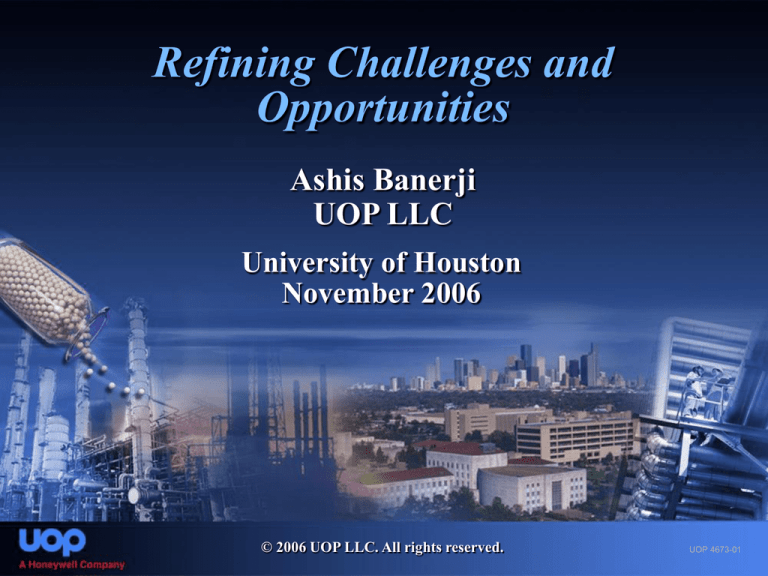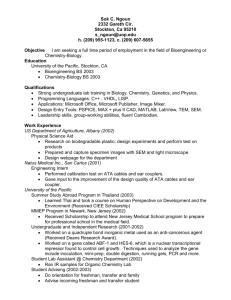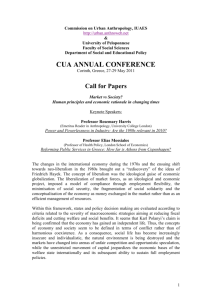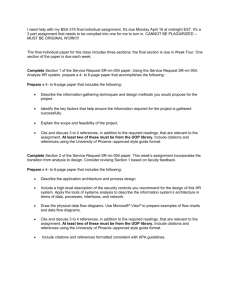
Refining Challenges and
Opportunities
Ashis Banerji
UOP LLC
University of Houston
November 2006
© 2006 UOP LLC. All rights reserved.
UOP 4673-01
Who We Are
Global company with
manufacturing sites
and offices in 16 countries
Over 2,800 highly trained
employees
Acquired by Honeywell in
2005
More than 90 years of
innovative solutions for the
hydrocarbon processing
industry
More than $1 billion in
revenues annually from
over 110 countries
UOP 4673-02
World’s Largest Process Technology
Licensing Organization
More
than 70 licensed processes
2,500 active patents
300+ catalysts
More than 150 Molecular sieve adsorbents
30+ engineered products
− Packaged process units and systems
− Proprietary equipment
− Control systems and instrumentation
Engineering, technical and training services
UOP 4673-03
What is Driving Change in the
North American Region?
Refining Utilization and
Demand Growth
25
20
90.0
15
85.0
10
80.0
5
75.0
0
2002
2007
Demand Growth
2012
N. America
2017
Europe
Asia
Demand Growth Mbpd
Utilization %
95.0
High
utilization combined
with growth
Growth of diesel is greater
than gasoline
Growth in light product /
declining resid
Processing heavy crudes
Regulations
Growth with utilization near sustainable limit more capacity
UOP 4673-04
Crude Oil Quality Trends
Global Crude Quality
1.3
34
– Increasing light / heavy price
differentials
1.25
33
API Gravity
Sulfur, %
1.2
1.15
1.1
1.05
Average crude quality declining
32
Significant impact on
desulfurization requirements
– Impact on heavy fuel oil
markets
– Light to heavy differential
increasing
Sulfur
API Gravity
1
31
(Sources: Purvin & Gertz)
1990 1994 1998 2002 2006 2010
Increasing residue conversion to transport fuels
UOP 4673-05
More Conversion Needed to
Process Heavy Crudes
Yield
Yield, wt%
100%
90%
C4-
80%
Lt Naph
70%
Hvy Naph
60%
50%
Kerosene
40%
Distillate
30%
20%
Hvy Gas Oil
10%
Resid
Heavier crudes yield
less gasoline and
distillate
Add conversion
needed
Heavier crudes
require hydrogen
addition to meet
distillate fuel quality
0%
Tapis
WTI
Arab
Med Maya
UOP 4673-06
Economic Price, $US 2004
Oil Resources As Function
of Economic Price
80
70
60
50
40
30
20
10
0
Arctic
Oil
Shales
Cumulative need to 2030
Deep
Water
Already
Produced
0
Source: IEA,
Resources to
Reserves, 2005
1000
OPEC
ME
E
O
R
Heavy Oil
bitumen
Other
Conv. Oil
2000
3000
Super
deep
4000
5000
6000
Available Oil, bn bbls
Heavy oil development viable at current prices
UOP 4673-07
North America Incremental Product
Demand
2006-2015
Additional Demand (KBPD)
1,400
1,200
1,000
800
600
400
200
0
Gasoline
Naphtha
Jet Fuel
Diesel
Resid Fuel
(Source: Purvin & Gertz)
Diesel demand increasing by 1.2 MMBPD (25% increase)
Gasoline demand increasing by 1 MMBPD (19% increase)
More diesel then gasoline with no resid fuel
UOP 4673-08
Product Specifications
Gasoline & Diesel
Biofuels
Low
Ethanol
/ ultra-low sulfur
legislation
More stringent benzene,
RVP specs
Further vehicle emissions
standards anticipated
– Tighter NOx standards
pursued in many
countries
US Renewable Fuels Standard
Widespread discussion of
biodiesel and green diesel
legislation
Fuel Oil
No
major changes for inland fuel oil
Bunkers remain growing fuel oil outlet
Clean fuels needs will continue to drive business
UOP 4673-09
Technology Innovations
are Key to Success
New flow schemes
– Maximize yield of high value products
– Flexible product slate
– Distressed stream processing
– Process integration
New catalysts
– Efficient hydrogen utilization
– Higher activity and yields
– Rapid catalyst
commercialization
UOP 4673-10
Examples of UOP Reforming Catalyst
Innovations
2005 R-98™ catalyst – high yields
2003 R-264™ catalyst - high density, high activity
R-274™ catalyst - high yield
2002
R-86™ catalyst - high yields, low costs
2001
R-234™ catalyst - low coke, increased flexibility
2000
R-72™ catalyst – high yields
1994
1993
R-132™ catalyst - high activity, surface area stable
R-56™ catalyst - maximum stability
1992
R-34 catalyst – low Pt version
1988
R-62™ catalyst – high stability
1983
R-32™ catalyst - lower Pt
1975
First CCR Platforming unit
1971
First SR Platforming unit
1949
UOP 4673-11
Continuous Innovation and Improvement:
Fluid Catalytic Cracking
Theoretical Octane Barrels
Octane Barrels / 100 Barrels Feed
6,200
New Reactor
Concepts
6,000
Improved Reaction
Systems
5,800
Octane Catalysts
5,600
Extended Riser
5,400
Zeolite Catalysts
5,200
5,000
Amorphous
Catalysts
Octane Barrel Capacity of FCC
4,800
1950
1960
1970
1980
1990
2000
UOP 4673-12
UOP Has Developed
Rapid Delivery of
High-Performance Catalysts
Drivers
Features
Levers
Metal
Clean Fuels
Yield
Yields
Hydrogenation
Flexibility
Activity
Low Cost
Stability
Function
Acidity
Pore Geometry
Char
Product Char
Reaction Engr
Tools
Technology
Catalyst Design
Engine
Catalysts
Process Models
Process
Feed
UOP Catalyst Design Engine (CDE) converted
fundamental knowledge and experimental database
into a computer model for catalyst design
UOP 4673-13
An Evolution in Perspective
Traditionally:
Viewed
catalysts from activity versus
selectivity standpoint
UOP 4673-14
An Evolution in Perspective
Now:
View catalysts from more dimensions
UOP 4673-15
An Evolution in Perspective
UOP 4673-16
An Evolution in Perspective
Now:
View
catalysts from more dimensions
Hydrogenation
is a key variable
UOP 4673-17
Synthetic Crudes and Heavy
Crudes Available in Market
Refining
Condensate
DilBit
Heavy
SCO
Light
SCO
Upgrading
Source: Purvin & Gertz, 2004
SynDilBit
SynBit
Heavy Crude/Bitumen
Production
Light
Synthetic
Crude Oil
(SCO)
Heavy
Crude
Refineries
Medium
Crude
Refineries
Light
Crude
Refineries
UOP 4673-18
Processing Heavy Crudes
Affect All Areas of the Refinery
High Resid Contnt
Coking or SDA
required
High contaminant
level
– High-severity
hydrotreating
High VGO content
after resid conversion
Synthetic Crudes
No resid content
– Blending with other
heavy crudes
Low-quality distillate
– High-severity
hydrotreating
Large volume of lowquality VGO
– FCC feed
pretreatment
UOP 4673-19
Processing Heavy Crudes
Affect All Areas of the Refinery
Bitumen Blends
High resid content
Synthetic Crudes
No resid content
– Coking or SDA
required
High contaminant
level
– High-severity
hydrotreating
High VGO content
after resid conversion
– Blending with other
heavy crudes
Low-quality distillate
– High-severity
hydrotreating
Large volume of lowquality VGO
– FCC feed
pretreatment
Additional VGO Conversion Required!
UOP 4673-20
Heavy Crude-derived VGOs are
Hydrogen Lean and Contaminant Rich
Property
Lt. Arabian Cold Lake Athabasca Coker
VGO
VGO
VGO
HGO
Gravity, °API
Sulfur, wt-%
Nitrogen, wppm
Hydrogen, wt-%
Total Aromatics, vol-%
22.7
2.10
820
12.47
58
16.3
3.10
1380
11.38
60
14.2
3.77
1854
10.80
69
11.4
4.99
4032
10.43
76
UOP 4673-21
Integration of Hydroprocessing and
FCC Operation is the Key to
Processing Bitumen-derived Crudes
Diesel
HDS
FCC
Gasoline
FCC Feed Hydrogen Content Must be Optimized
UOP 4673-22
FCC Feed Pretreating
is Not Always the Right Solution
FCC capacity still limited by high VGO
content of heavy and synthetic crudes
High-quality distillate fuels
cannot be produced in an
FCC unit
UOP 4673-23
Hydrocracking Required to Convert
Incremental VGO and Produce
Right Product Mix
Diesel
Unionfining™
FCC
Gasoline
Gasoline
Unicracking™
Diesel
FCC
Gasoline
UOP 4673-24
Is the Once-through
Unicracking Process the Right Choice?
Higher yields of naphtha and distillate
Higher quality FCC feedstock
Flexibility to adjust conversion
for seasonal demand
UOP 4673-25
Once-through Unicracking Process Produces
FCC Feed with High Hydrogen Content
H2
R-1
61.5
R-2
5
64
Naphtha
12
Kerosene
16 mm Smoke Point
17
Heavy Diesel
45 Cetane No.
FCC Feed
30
Feed
60
UOP 4673-26
30
80
25
70
20
60
15
50
10
5
40
0
30
100
0
20
40
60
80
Diesel Cetane Index
Kerosene Smoke Point, mm
Increased Conversion Produces
Higher-quality Fuels
Conversion, wt-%
Conventional VGO Feed
UOP 4673-27
Is Recycle or Co-Processing
Unicracking Process the Right Choice?
Once-Through hydrocracking mode has
poor hydrogen utilization
- Lower light product quality
- Sub-optimal hydrogen
content of FCC feed
Alternative flow schemes
needed for independent
control of product quality
UOP 4673-28
Separate-hydrotreat Configuration
Provides Flexibility
H2
30
R-2
11
Naphtha
R-1
Kerosene
95
16 23 mm Smoke Point
8
Heavy Diesel
57 Cetane No.
FCC Feed
30
30
Feed
60
Independent Control of Distillate
and FCC Feed Qualities
UOP 4673-29
Advanced Partial-conversion Unicracking
(APCU) Integrates FCC Feed
Pretreatment with ULSD Production
H2
Co-feed
VGO
Feed
AMINE
Fractionation
PT
Rx
HT
Rx
HC
Rx
SEP
E
H
S
ULSD
Enhanced Hot
Separator
FCC Feed
UOP 4673-30
Catalysis and Catalytic Processes
will Enable increased Utilization
of Heavy Oil in the USGC
Hydrogenation optimizes FCC feed
hydrogen content
Produces high-quality distillate fuels to
meet growing demand
Diesel produced can meet all ULSD specs
Product slate can be seasonally adjusted
UOP 4673-31
UOP 4673-32







